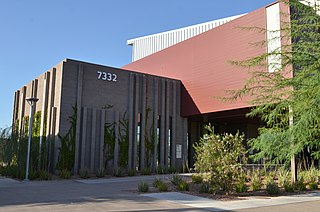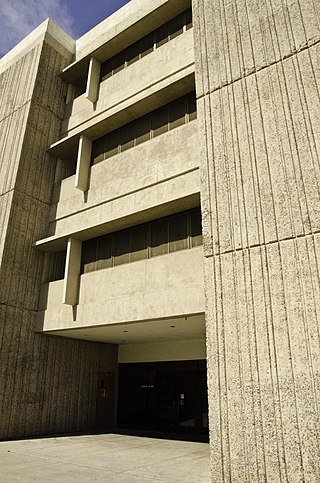
Arizona State University is a public research university in the Phoenix metropolitan area. Founded in 1885 by the 13th Arizona Territorial Legislature, ASU is one of the largest public universities by enrollment in the United States.

Flagstaff is a city in, and the county seat of Coconino County, Arizona, in the southwestern United States. As of the 2020 United States census, the population was 76,831.

Coconino County is a county in the north-central part of the U.S. state of Arizona. Its population was 145,101 at the 2020 census. The county seat is Flagstaff. The county takes its name from Cohonino, a name applied to the Havasupai people. It is the second-largest county by area in the contiguous United States, behind San Bernardino County, California. It has 18,661 sq mi (48,300 km2), or 16.4% of Arizona's total area, and is larger than each of the nine smallest states in the U.S.

The Wupatki National Monument is a United States National Monument located in north-central Arizona, near Flagstaff. Rich in Native American archaeological sites, the monument is administered by the National Park Service in close conjunction with the nearby Sunset Crater Volcano National Monument. Wupatki was established as a national monument in 1924 and was listed on the National Register of Historic Places on October 15, 1966. The listing included three contributing buildings and 29 contributing structures on 35,422 acres (14,335 ha).

Northern Arizona University (NAU) is a public research university based in Flagstaff, Arizona. Founded in 1899, it was the final public university established in the Arizona Territory, 13 years before Arizona was admitted as the 48th state.

Diné College is a public tribal land-grant college in Tsaile, Arizona, serving the 27,000-square-mile (70,000 km2) Navajo Nation. It offers associate degrees, bachelor's degrees, and academic certificates.

Prescott College is a private college in Prescott, Arizona.

Arizona State University Polytechnic Campus is a public university in Mesa, Arizona. It is one of five campuses of Arizona State University. Founded as ASU East, the campus opened in fall 1996 on the former Williams Air Force Base in southeast Mesa.
The City Colleges of Chicago is the public community college system of the Chicago area. Its colleges offer associate degrees, certificates, free courses for the GED, and free English as a second language (ESL) courses.
Grady Gammage was an Arizonan educator. He served as the president of Northern Arizona University from 1926 to 1933 and as the president of Arizona State University from 1933 to 1959. In 1958, he led Arizona State College’s victorious Proposition 200 campaign in the state legislature for a name change to Arizona State University. Gammage Auditorium at ASU was named in his honor.
Fredonia-Moccasin Unified School District is a school district headquartered in Fredonia, Arizona, United States.

Coconino High School (CHS) is a public secondary school located in Flagstaff, Arizona (US). It is part of the Flagstaff Unified School District and is one of the district's three high schools.
South Beaver Elementary School was an elementary school in Flagstaff, Arizona. The school was a part of Flagstaff Unified School District (FUSD) up until its closure in 2010. However, the school was leased, and later purchased, by Northern Arizona University (NAU) and is now used for the intensive English program for non-native English speakers.
Cosnino is a populated place situated in Coconino County, Arizona, United States, located several miles east of Flagstaff, the county seat.
James Lawrence Walkup was an American academic administrator who served as the eleventh president of Northern Arizona University from 1957 to 1979. He developed the school from a teachers' college to one with 152 degree specializations.
Riordan was a populated place situated in Coconino County, Arizona, United States. It has an estimated elevation of 7,316 feet (2,230 m) above sea level.

Edward Leighton Varney Jr. (1914–1998) was an American Modernist architect working in Phoenix, Arizona from 1937 until his retirement in 1985. He designed the Hotel Valley Ho in Scottsdale, and Sun Devil Stadium at Arizona State University. In 1941, he began his career, which would extend to his retirement in 1985. His firm would continue designing buildings into the 1990s.

Fred Melville Guirey (1908-1984) was an architect working in Phoenix Arizona from the 1930s to the 1980s. Over his career his firm produced many works some of which are considered exceptional examples of Mid-Century Modern, and Brutalist architecture.
On October 9, 2015, Steven Edward Jones, an 18-year-old freshman at Northern Arizona University, shot four people, killing Colin Charles Brough and severely injuring three others, in a parking lot outside of Mountain View Hall on the Flagstaff Mountain campus in Flagstaff, Arizona.

Downtown Flagstaff, Arizona sits in the western part of the city, and consists of several culturally-connected blocks. The city of Flagstaff has a downtown culture of local, independent stores inside historic buildings.












